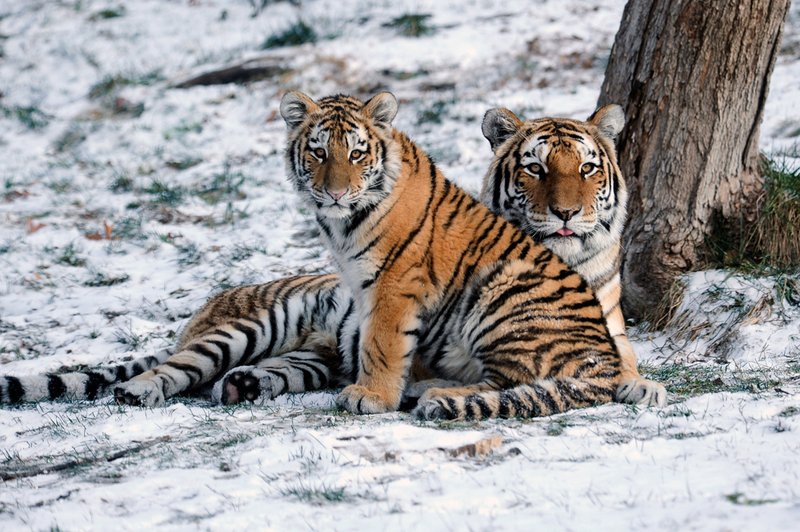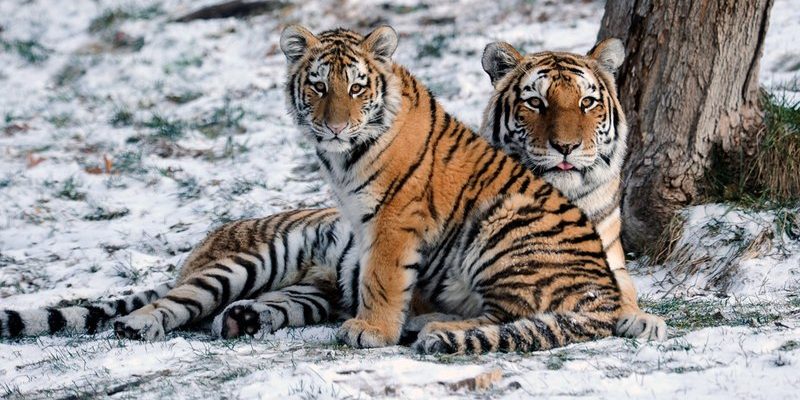
These tigers have adapted in a variety of remarkable ways to handle their icy homes in Siberia and parts of China. It’s not just about staying warm; it’s also about hunting, shelter, and even social behavior. Let’s dive into the fascinating world of Siberian tigers and explore how they conquer the cold.
Adaptations for Cold Weather
Siberian tigers are true experts at surviving low temperatures. One of their most impressive features is their thick fur coat. This isn’t just for show; the dense undercoat traps warmth, while the longer outer hairs repel moisture and wind. It’s almost like wearing a built-in winter jacket that adjusts with the weather—pretty cool, right?
Their bodies are also built for the cold. Siberian tigers have a layer of fat beneath their skin that serves as insulation, keeping them warm even in the chilliest weather. You might think of it as nature’s version of thermal underwear. Additionally, their large paws are like snowshoes, helping them move efficiently through the snow without sinking. This clever design allows them to cover large territories while hunting or searching for resources.
Here’s the thing: their adaptations don’t stop at just physical traits. Siberian tigers have a keen ability to sense changes in their environment. They can detect the faintest scents on the wind and hear sounds from great distances, which helps them locate prey or avoid threats. In a place as harsh as Siberia, being aware of your surroundings is a critical survival skill.
Finding Food in Scarce Conditions
Hunting in the wild can be quite a challenge, especially when food sources are limited. Siberian tigers primarily hunt deer, boar, and other large mammals. Their hunting strategy is truly fascinating. These tigers rely on stealth and patience, often stalking their prey silently through the snow. Imagine a high-stakes game of hide-and-seek, where one wrong move can mean the difference between a meal and empty stomach.
When hunting, they typically use their strong back legs to launch a powerful ambush. This is where those big muscles pay off. A Siberian tiger can leap impressive distances, making them excellent ambush predators. It’s a bit like being a professional athlete; they train (through practice) every day just by surviving in the wild.
However, food isn’t always readily available. Siberian tigers are solitary creatures, which means they cover vast territories. This helps them find food and ensures they don’t overhunt a single area. By roaming large stretches of land, they give prey populations a chance to recover, maintaining a delicate balance in their ecosystem.
Shelter and Territory
Finding a good place to rest is essential for Siberian tigers. They usually seek out dense forests, where they can hide from both the cold and potential threats. These areas not only provide cover but also a good vantage point to watch for prey. When it comes to shelter, these tigers might utilize caves, large fallen trees, or even dense thickets for protection from harsh winds and heavy snow.
You might be curious about how they define their territory. Siberian tigers are known for being quite solitary and often mark their territory with scent markings. This serves two purposes: it tells other tigers to keep their distance, and it helps them keep track of their hunting grounds. You could think of it as putting up a “no trespassing” sign in a way that’s both subtle and effective.
Despite their solitary nature, these tigers sometimes form loose associations, especially during mating season. This temporary companionship allows them to ensure the survival of their species. It’s a reminder that even the fiercest predators understand the importance of connection, if only for a short time.
Behavioral Adaptations
Siberian tigers also exhibit intriguing behavioral adaptations that enhance their survival. For example, during the colder months, they tend to adjust their activity levels. Instead of prowling around all day, they might become more nocturnal, hunting at night when temperatures drop. This strategy not only conserves energy but also allows them to avoid detection by prey.
Their ability to adapt their behavior extends to their communication methods, too. Siberian tigers use various vocalizations, body language, and scent marking to communicate with other tigers. Whether it’s a deep roar echoing in the night or a subtle scent trail left behind, these communicative strategies are key to their survival. It’s like possessing a whole toolkit full of social cues designed for the wilderness.
Additionally, the way they interact with their environment reflects their adaptability. Siberian tigers are known to be resourceful, often scavenging leftovers from other predators. If they can’t catch a meal themselves, they might follow wolves or other hunters to see if they can snag a free meal. This knack for adaptability is a crucial part of their survival strategy in the fierce Siberian wilderness.
The Impact of Climate Change
While Siberian tigers are tough, they’re not invincible. Climate change poses a significant threat to their habitat and food sources. Warmer temperatures can alter the ecosystems they rely on, leading to changes in prey behavior and availability. Imagine how difficult it would be to find food if the animals you rely on changed their patterns due to shifting seasons.
Moreover, habitat loss due to human activity further compromises their survival. Deforestation and urban development encroach on their natural environments, making it harder for these cats to find safe places to live and hunt. It’s like having your home resized without your consent—suddenly, you have less room to breathe.
Conservation efforts are crucial in addressing these challenges. Protecting their natural habitats and ensuring sustainable practices can help keep Siberian tigers thriving for generations to come. By raising awareness and supporting wildlife protection initiatives, we can work together to ensure these majestic creatures continue to rule the snowy expanse of their northern home.
Siberian tigers are nothing short of remarkable. Their ability to survive in harsh environments showcases the wonders of nature and the resilience of life. From their thick fur and powerful hunting strategies to their solitary yet adaptable behaviors, they embody the spirit of survival against the odds. However, the challenges they face from climate change and habitat loss remind us of the importance of conservation.
By understanding how these tigers thrive, we also learn about the delicate balance of ecosystems and the role each creature plays. Supporting efforts to protect them not only helps the tigers but also preserves the rich biodiversity of their habitats. So, the next time you marvel at a picture of a Siberian tiger, remember the resilience and adaptability that allows it to thrive in one of the world’s most challenging environments. Let’s work together to ensure their future in the wild.

